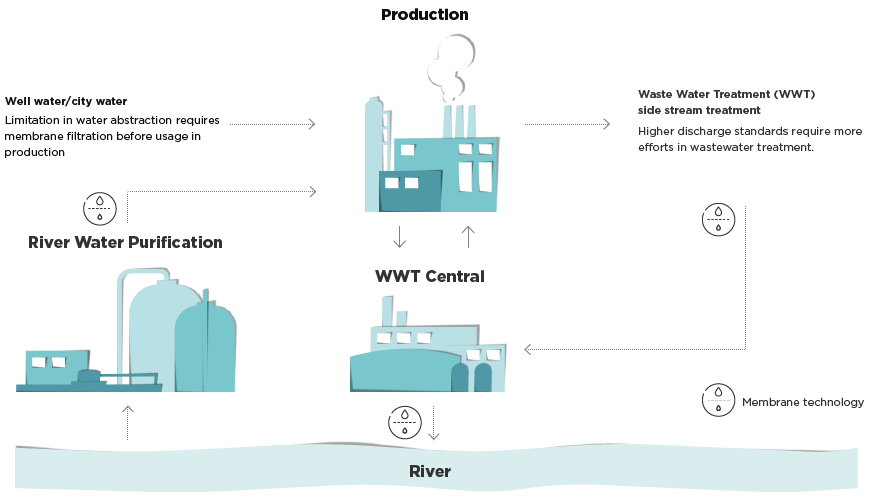In Eastern Spain, in Catalonia, lies a both ancient and modern city that boasts thriving human innovation: the city of Tarragona. Dry, yet saturated with culture and Mediterranean beaches, Tarragona hosts an archeological world heritage site and a cluster of chemical companies, including Clariant. Recognizing that responsible water use is an extremely important environmental issue now and in the future, Clariant joined a wastewater treatment project introduced in 2016 known as INSPIREWATER to help pursue its ambitious water goals – reducing water consumption by 35% and wastewater by 40% per ton of produced goods between 2013 and 2025. Based in the microcosm of chemical companies nestled in Tarragona’s water-limited region, INSPIREWATER brings together eleven industrial and scientific partners through a European Union-funded grant to explore wastewater treatment efficiencies using innovative membrane technologies at Clariant’s Tarragona site. The eleven partners of the consortium span eight industries, including steel, paper, and chemicals, and the project is funded by the European Union’s (EU) framework program for research and innovation, Horizon 2020. Clariant represents the chemical industry within the consortium and provides the testing ground for innovative wastewater treatment solutions.
»To Clariant, the best wastewater is wastewater that barely exists.«
Friedhelm Zorn Head of Competence Center Environmental Technologies
Solutions to better wastewater management
Like societies at large, Clariant depends on a healthy environment and the long-term availability of natural resources, including water. As a result, Clariant strives to reduce freshwater consumption as much as possible, especially as water shortages increase in frequency in many regions. In the province and city of Tarragona, where reduced river volumes put pressure on local municipal and industrial consumption, Clariant focuses on advanced technologies applied in new combinations to enhance performance and create optimal recycling conditions. This not only supports Clariant in creating sustainable technologies that reduce impact on the environment, it also limits increases in production costs.
Water use and waste water declining
Over the past four years, water consumption at Clariant’s production facilities decreased from 71 m m3 to 48 m m3, while waste water declined from 20 m m3 to 13 m m3.
Beyond the Tarragona microcosm
Although the individual technologies integrated by INSPIREWATER are not new, their combined use is innovative for effluent treatment as they work in harmony to enhance the efficiency of the wastewater treatment processes. On top of that, INSPIREWATER’s innovative use of membrane technology helps Clariant achieve its ambitious wastewater reduction goals.
With these environmental goals in mind, Clariant believes INSPIREWATER has both broad benefits and broad applications, creating not only end-of-pipe wastewater treatment solutions with energy and emission reductions, but also a knowledge base for possible applications within earlier stages of the production process. For example, in other regions with more abundant river water resources, Clariant may be able to pre-treat these water sources as production inputs and purify wastewater across its operations for recycling within production. This creates multiple uses for every drop of water needed.
Saving resources and reducing environmental impact may ultimately start a ripple effect among Tarragona’s microcosm of chemical companies. However, INSPIREWATER also has the potential to create a tidal wave of enhanced solutions for sustainable water use by companies across the globe – with Clariant helping lead the charge.
Striving for ambitious environmental targets
An integrated plan for water treatment
By utilizing a multi-membrane technology, Clariant sidesteps high costs and energy requirements.
INSPIREWATER is a public-private partnership (PPP) by Clariant and 10 other partners. The concept helps to reduce wastewater up to zero liquid discharge and fresh water consumption by recycling of cleaned waste water. At the same time, energy consumption is reduced by efficient waste water treatment (WWT). Using Clariant’s Tarragona facility as a testing ground, it takes a renewed approach to water treatment. By utilizing a multi-membrane technology that incorporates anti-fouling, catalysts, and forward osmosis with standard reverse osmosis techniques, Clariant sidesteps high costs and energy requirements of using reverse osmosis alone. Unlike reverse osmosis, the semi-permeable membrane involved in forward osmosis does not require hydraulic pressure, therefore reducing cost and energy.

